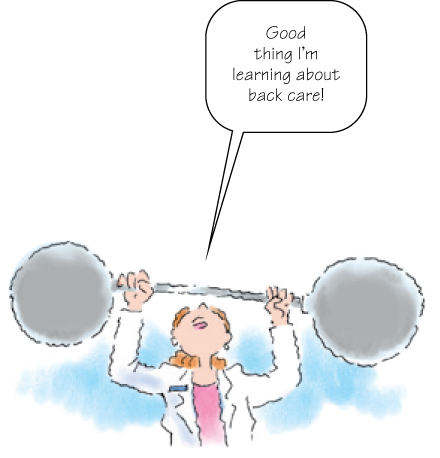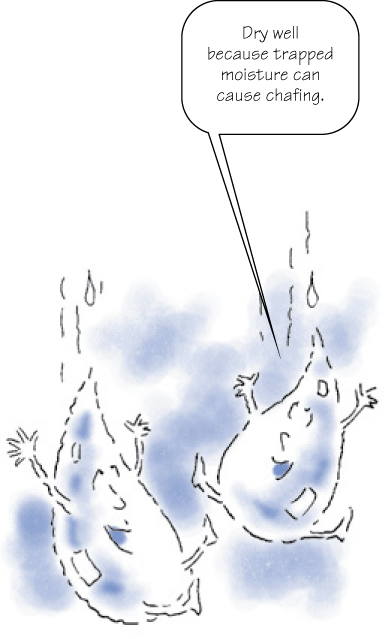Regular bathing and massage of the neck, back, buttocks, and upper arms promotes patient relaxation and allows assessment of skin condition. Particularly important for the bedridden patient, massage causes cutaneous vasodilation, helping to prevent pressure ulcers caused by prolonged pressure on bony prominences or by perspiration. Although you can perform gentle back massage after a patient has a myocardial infarction, it may be contraindicated in those with rib fractures, surgical incisions, or other recent traumatic injury to the back.

Basin  soap
soap  bath blanket
bath blanket  bath towel
bath towel  washcloth
washcloth  back lotion with lanolin base
back lotion with lanolin base  gloves, if the patient has open lesions or has been incontinent
gloves, if the patient has open lesions or has been incontinent  optional: talcum powder.
optional: talcum powder.
Fill the basin two-thirds full with warm water. Place the lotion bottle in the basin to warm it. Application of warmed lotion prevents chilling or startling the patient, thereby reducing muscle tension and vasoconstriction.
Assemble the equipment at the patient's bedside.
Explain the procedure to the patient and provide privacy. Ask him to tell you if you're applying too much or too little pressure.
Adjust the bed to a comfortable working height and lower the head of the bed, if allowed. Wash your hands and put on gloves, if applicable.
Place the patient in the prone position, if possible, or on his side. Position him along the edge of the bed nearest you to prevent back strain.
Untie the patient's gown and expose his back, shoulders, and buttocks. Then drape the patient with a bath blanket to prevent chills and minimize exposure. Place a bath towel next to or under his side to protect bed linens from moisture.
Make it into a mitt
Fold the washcloth around your hand to form a mitt. This prevents the loose ends of the cloth from dripping water onto the patient and keeps the cloth warm longer.
Work up a lather with soap. Using long, firm strokes, bathe the patient's back, beginning at the neck and shoulders and moving downward to the buttocks.
Rinse and dry
Rinse and dry well because moisture trapped between the buttocks can cause chafing and predispose the patient to pressure ulcers.
While giving back care, closely examine the patient's skin, especially the bony prominences of the shoulders, the scapulae, and the coccyx, for redness or abrasions.

Moisturize first, then massage
Remove the warmed lotion bottle from the basin and pour a small amount of lotion into your palm. Rub your hands together to distribute the lotion.
Apply the lotion to the patient's back using long, firm strokes. The lotion reduces friction, making back massage easier.
Massage the patient's back, beginning at the base of the spine and moving upward to the shoulders. For a relaxing effect, massage slowly; for a stimulating effect, massage quickly. Alternate the three basic strokes: effleurage, friction, and pétrissage. (See How to give a back massage.) Add lotion as needed, keeping one hand on the patient's back to avoid interrupting the massage.
Compress, squeeze, and lift the trapezius muscle to help relax the patient.
Finish the massage by using long, firm strokes and blot any excess lotion from the patient's back with a towel. Then retie the patient's gown and straighten or change the bed linens, as necessary.
When you're done
Return the bed to its original position and make the patient comfortable. Empty and clean the basin.
Dispose of gloves, if used, and return equipment to the appropriate storage area.
Before giving back care, assess the patient's body structure and skin condition and tailor the duration and intensity of the massage accordingly.
If the patient has oily skin, substitute a talcum powder or lotion of the patient's choice. However, don't use powder if the patient has an endotracheal or tracheal tube in place to avoid aspiration.
Don't massage the patient's legs unless ordered because reddened legs can signal clot formation and massage can dislodge the clot, causing an embolus.
Give special attention to bony prominences because pressure ulcers are common in these areas.
Keep the powder and the lotion separate
Avoid using powder and lotion together because this may lead to skin maceration.
If you're giving back care at bedtime, have the patient ready for bed beforehand so the massage can help him fall asleep.
Develop a turning schedule and give back care at each position change. (See Documenting back care.)
Outline
